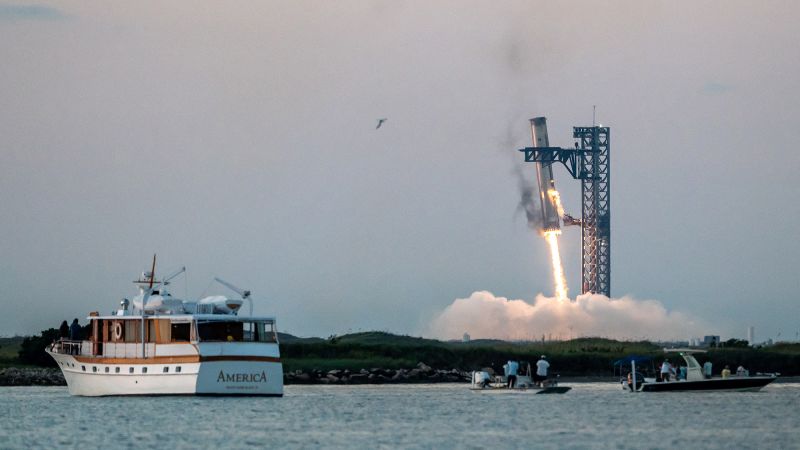In recent space exploration news, SpaceX has accomplished a remarkable feat with its Super Heavy rocket booster, which is approximately as tall as a 20-story building. This booster made an impressive comeback to the skies over South Texas minutes after its launch in October, reigniting its engines to ensure a controlled descent back to Earth. This event showcased the company’s capability for midair precision, landing directly into the supportive arms of its launch tower, captivating audiences far and wide.
The anticipated event was part of a test flight for SpaceX’s Starship, a project widely acknowledged as the most powerful rocket system ever built. Many viewers experienced the thrilling sight via live-streamed broadcasts, yet only those in proximity to the launch site could truly appreciate the jaw-dropping roar that accompanied the launch. Indeed, as the Super Heavy made its return journey, an enormous sonic boom rippled through the air, leaving many in awe.
Noah Pulsipher, an undergraduate student specializing in applied physics at Brigham Young University, expressed his astonishment at the noise levels associated with the launch. He described it as one of the loudest experiences he had ever encountered, which was particularly noticeable since the sound resonated as far as popular tourist destinations miles away. According to a study published in November in the journal JASA Express Letters, the sonic boom from Super Heavy was akin to the sound of gunfire at close range.
Given that SpaceX has conducted a total of six test flights from its near-Brownsville, Texas launch site, known as Starbase, only the October test flight—designated as Flight 5—has successfully witnessed the Super Heavy booster return unharmed. Anticipation continues to build as the Federal Aviation Administration (FAA) has already approved Flight 7, ideally setting the stage for another booster landing.
The Super Heavy booster plays a vital role within the Starship system, propelling the Starship spacecraft to its initial stages and then returning to the launchpad in an innovative and efficient manner. However, the sonic booms generated during this extraordinary maneuver may raise environmental concerns, given that they could potentially lead to hearing damage for individuals located in areas surrounding the Gulf of Mexico, as noted by officials.
Although no visible damage was observed following the Super Heavy’s successful soft landing, experts advocate for continued monitoring of sonic boom impacts. Dr. Victor Sparrow, an acoustic specialist, highlighted the necessity for vigilant observation, especially since variations in individual sensitivity and resilience to noise pollution may pose problems for certain residents.
While some in the SpaceX community have shown unwavering support for the project, it remains unclear how local populations will react to the company’s ambitious plans for numerous Starship flights per year—potentially leading to the same controversies surrounding sonic booms that have affected previous high-profile aerospace projects. The sonic boom phenomenon entered the public consciousness during the supersonic aviation era of the mid-20th century when the sound created by an object traveling faster than the speed of sound became a hot topic.
SpaceX’s sonic boom discussions are reigniting collective memories of the Concorde, a supersonic jet that was revered for its incredible speed but ultimately faced challenges due to its association with disruptive sonic booms. Interestingly, SpaceX is currently the only company globally that routinely returns rockets to pinpoint landings after launches, initiating sonic booms in the process—an impressive achievement refined over years of experience with the Falcon 9 rocket series.
Research from Brigham Young University suggests that launching Starship may produce sonic booms equivalent to ten Falcon 9 rocket launches due to its immense size. Measurements taken during the October launch revealed sonic boom pressure levels, with one resident noting that the experience felt reminiscent of a weight placed on the chest, demonstrating the tangible impact of the sound waves unleashed by the rocket.
Currently, researchers are racing against time to gather more data on the booms associated with future Starship launches. As sound levels from sonic booms rise above 140 decibels, associated risks for hearing loss elevate significantly, with the potential for property damage also emerging as a consideration. Such assessments will ultimately shape regulatory frameworks as SpaceX presses towards its mission of increased launch frequency, potentially expanding to 25 Starship flights per year.
The FAA has indicated that it remains vigilant regarding sound levels linked to Starship launches at the Starbase facility. If environmental assessments conclude that sound exposure may lead to significant impacts on local properties or people, it could prompt regulatory measures designed to mitigate effects on surrounding communities.
For their part, SpaceX continues to strive for public alignment, portraying Starship missions as monumental steps toward human exploration of Mars, while also aiding NASA’s lunar missions. By emphasizing the monumental nature of its operations, the company hopes to frame sonic booms as heralds of a remarkable future in space travel, advocating for a narrative that prioritizes innovation and exploration above discomfort. As the world watches, only time will reveal how these bold ambitions will harmoniously coexist with the challenges of sonic booms and community responses in



